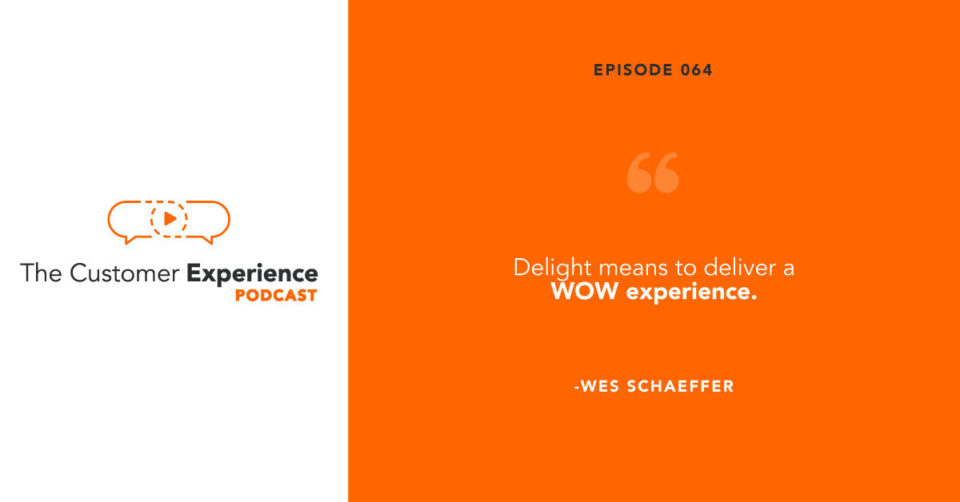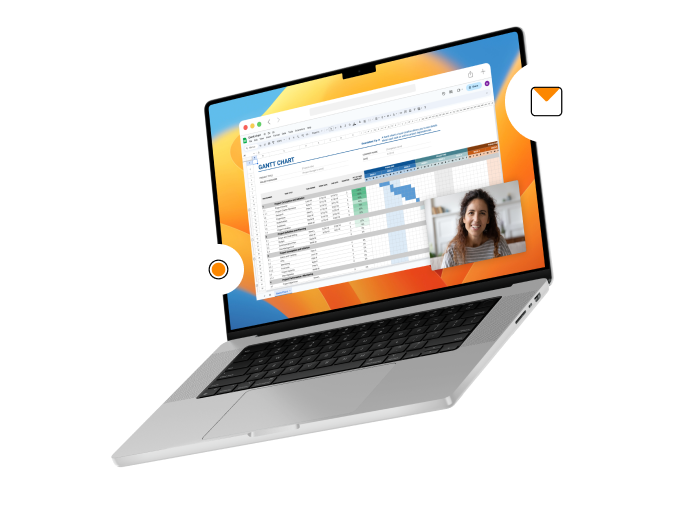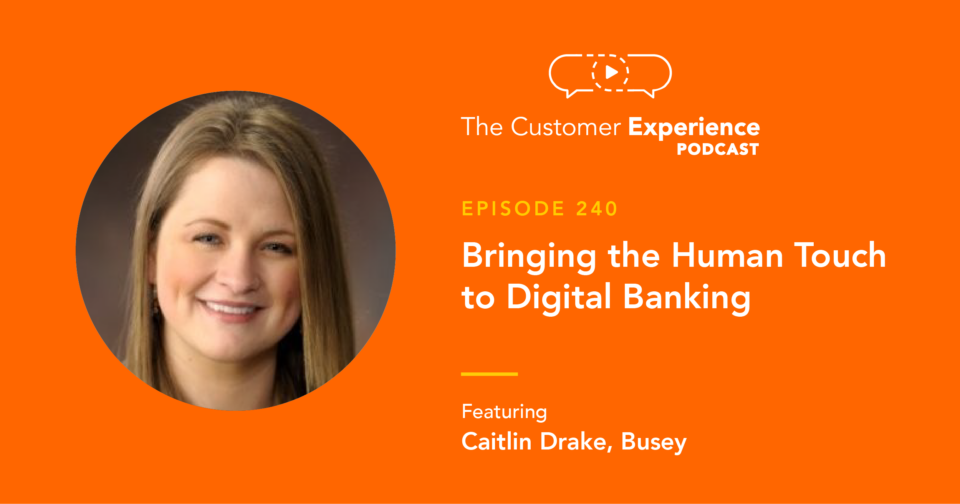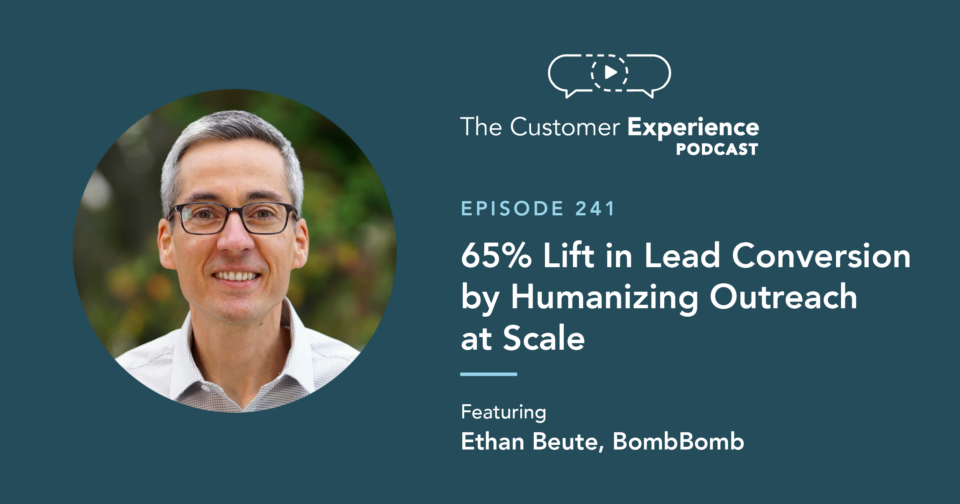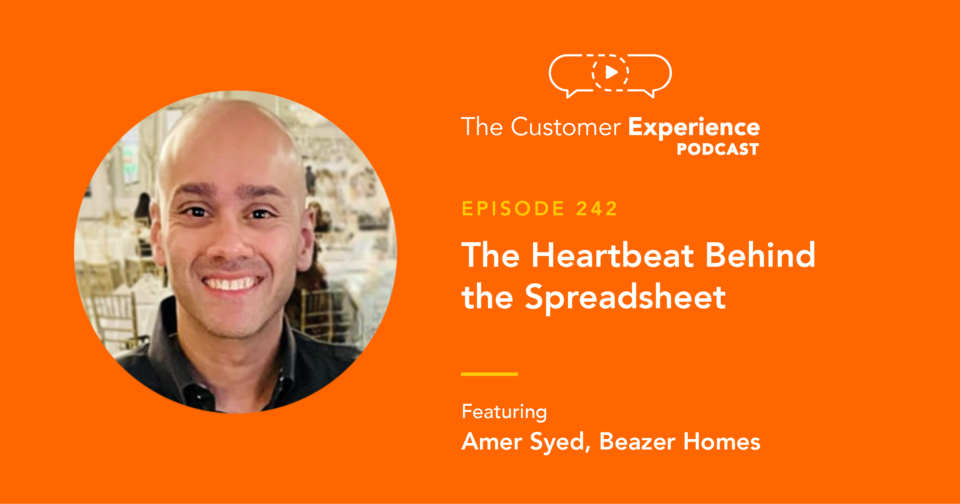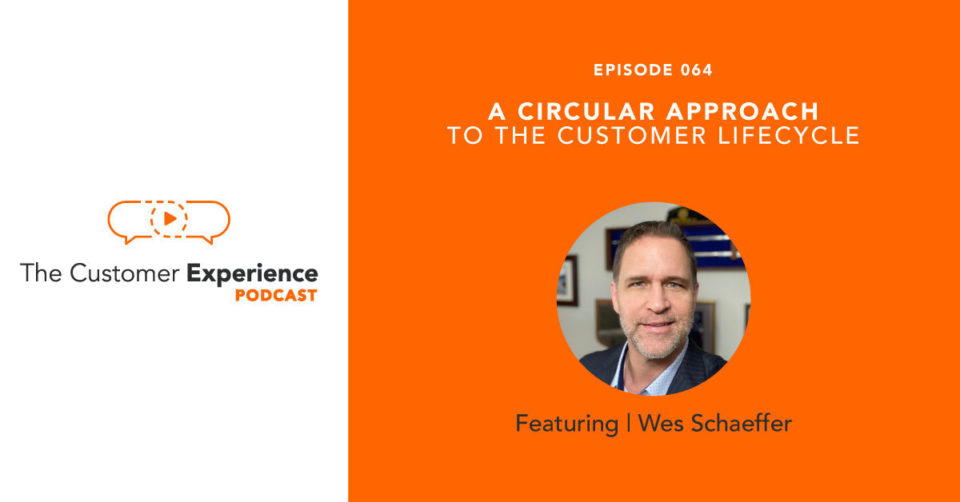
Listen to “64. A Circular Approach to the Customer Lifecycle w/ Wes Schaeffer” on Spreaker.
Apple Podcasts | Google Podcasts | Stitcher | Spotify
How do you think of the customer lifecycle? Is it linear – starting with a prospect and ending with a customer? Or is it circular? The latter is your best bet if you want lifelong customers. And it’s as easy as ABC…DE.
- Attract
- Bond
- Convert
- Deliver
- Endear
Then, repeat.
This is because a customer journey doesn’t just have a beginning and an end. The circular movement cultivates loyalty that will keep your customers coming back to you.
If you’re not clear exactly what this means for your sales and marketing team, this episode is for you.
Wes Schaeffer, aka The Sales Whisperer, joins us on The Customer Experience Podcast to break down this circular approach to the customer lifecycle.
He consults on sales enablement and customer relationship management and delivers training on sales and marketing processes. He also hosts The Sales Podcast and CRM Sushi Podcast.
In this episode, we discuss his model of a circular customer lifecycle. Conversation points include …
• What an ideal customer lifecycle looks like – courtesy of BMW
• How the ABCDE process works
• When to use automation vs personal touch
• Why doing things that don’t scale is important
• How to keep the personal and the human in the sales process
• How to create a positive upward spiral, rather than a race to the bottom
Listen to the entire conversation with Wes Schaeffer, The Sales Whisperer, right here:
Listen to “64. A Circular Approach to the Customer Lifecycle w/ Wes Schaeffer” on Spreaker.
Of course you can also subscribe, listen, and rate/review the podcast on:
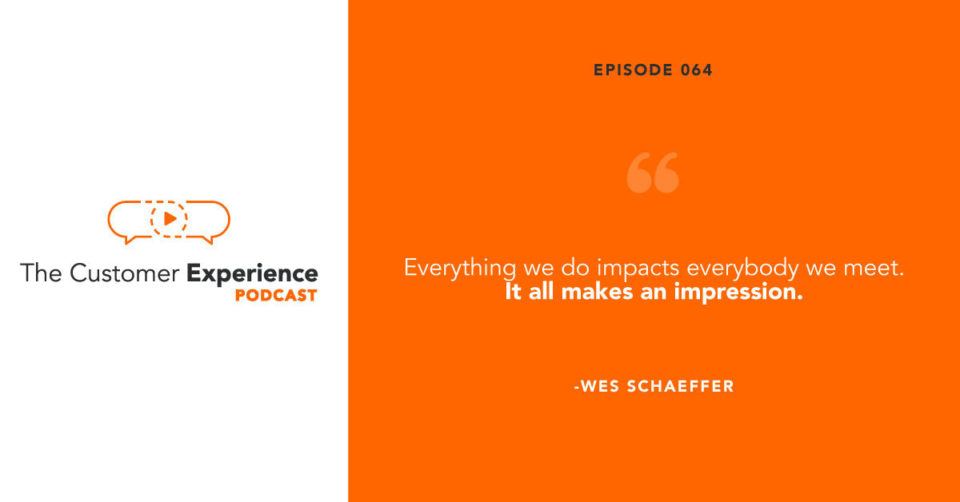
Full Transcript: A Circular Approach to the Customer Lifecycle
Ethan Beute:
Hey, welcome back to The Customer Experience Podcast. For today’s guest, the customer journey isn’t linear, it’s circular and it’s as easy as ABCDE: attract, bond, convert, deliver, endear. We’ll be getting more into the ABCDE sales and marketing method. We’ll also get into the two things customers say they’ll pay for the limits of automation and more as the sales whisperer. He consults on CRM, trains on sales and marketing process and hosts more podcasts than I do. Wes Schaeffer, welcome to the Customer Experience podcast.
Wes Schaeffer:
Hey man, thanks for having me.
Ethan Beute:
Just really an interesting background. You have a degree in meteorology. You played football at the Air Force Academy. You served in the Air Force and I think you were using your meteorology degree in the Air Force. How did you land in sales and marketing and tech and process?
Wes Schaeffer:
I wanted to be paid according to my production and yeah, once my five years were up, I started laying the groundwork about a year early, to make the transition. I was married, we had a baby, had another one on the way, so I couldn’t just throw caution to the wind. So yeah, made some plans, they all changed within six months. But hey, at least I had some plans, but I was always interested in sales. I was motivated to make more money, and sales was the clear path.
Ethan Beute:
It is a clear path. It’s funny, it took me, I interned at a television station while I was in college and it didn’t take me very long to connect who in the building was driving the nicest cars. And so that occurred to me immediately and yet I still spent a dozen years on the creative side of the business. Let’s start where we always start here, which is your thoughts around customer experience. When I say customer experience, what does that mean to you?
Wes Schaeffer:
I learned a fancy word in this world of marketing years ago called congruency and how it applies in marketing and sales, but it applies in life. If you see somebody talking about like fancy cars, whatever, they’re driving a nice car, but they get out in there in, I don’t know, grungy clothes and they don’t talk clearly or precisely. You’re like, something’s not congruent. There’s something that doesn’t match. The driver doesn’t match my image of the car. We make those judgments about people all the time. But in business, if you have an ad that promises the moon and the stars and the website loads slowly or it’s outdated or it’s loading flash and playing Air Supply at level 10, it’s incongruent.
Wes Schaeffer:
If the ad looks good, the landing looks good, you fill out a form, you don’t hear from somebody or it’s a pushy sale or somebody immediately calls and starts texting and hounding you, you’re like, it’s not congruent. It’s not a seamless transition. And so a confused mind says no. All right. So if anything is not a match, then we protect ourselves. We kind of back up and say, “I must have missed something. Let me reevaluate. I’ll take a moment and I’ll get back to you.” Like we say in sales time kills deals, so everything must match and not only up to the sale. Because rookies and amateurs and the money chasers, they stop at the sale.
Wes Schaeffer:
But we all know, people file chargebacks, they ask for refunds, they return the product or they keep the product and they go on Yelp and everywhere else and give you a one star review and make your life miserable. It’s like golf, you swing through the ball, swing through impact. It’s true in any sport. Tennis, baseball. Anything you’re striking the ball, swing through impact, martial arts, swing through the strike. So you must continue selling through the conversion, the cash, if you’re really going to make it in the world of sales,
Ethan Beute:
I think you’re right on there. This is obviously where you get repeat purchasing, expanded purchasing, purchasing of different products and services that were available, but you didn’t take on the first go, to your point online reviews, testimonials and the entire positive growth loop or positive halo effect of having that congruency from start to finish. Great call there. Where do you think some, you consult, you review a lot of situations, you probably walk into great situations and kind of maybe some crazy situations. Where do you see some companies getting it really right or really wrong with regard to congruency in customer experience?
Wes Schaeffer:
Oh well man, my local guy here, I bought a couple of BMWs from a guy and they were outstanding, still outstanding and they over-delivered and I could say, I guess conversely, the local Ford dealer, this was years ago and I had my heart set, I was getting a truck. Been out of Texas too long, it was time for a truck. I’m just saying. And I went to the local Ford dealer and I’ve almost never bought a new vehicle. And I just told the guy straight up, “What’s your best deal?” I’m looking at diesel’s but I could do this, that and the other and they wanted to play games. They were going to go appraise my vehicle, started to look for something on the lot. I said, “Okay, fine.” When they walked, they turned right. I grabbed my keys, told my wife, “Let’s go”.
Wes Schaeffer:
And I had an appointment at the BMW dealership anyway, so when I pulled up the car I was looking at was backed in right in the front. They had this, I remember they had this like three, three and a half foot tall placard. It was this plastic stand that came up and then angled back and it had a space for a piece of paper and they had just printed up my name like reserved for Wes Schaeffer or welcome Wes Schaeffer or something like that. That little stand probably cost 50 bucks and that sheet of paper cost two pennies and it made an impression. They were not pushy, they didn’t play games and I was like done. And I’ve referred him more people, ended up buying three cars from them and all because they weren’t pushy. They didn’t play the games, cut to the chase, got to know me, knew I wasn’t playing any games and they made the sale.
Ethan Beute:
Love it. And here you are talking about it years later and I’m sure you’ve done it many times before. It’s the first story that came to mind. Such as a little bit of care and attention obviously left a significant impact and that’s what we’re all trying to do. So let’s get into your philosophy around linear versus circular and your ABCDE system. And unless anyone hit the bounce back button, they don’t remember what the words mean. So talk a little bit about that. What was the epiphany for you or how did you start going down the circular road and then maybe get a little bit into the system?
Wes Schaeffer:
Yeah, well, I mean I’m always a student. I’m learning, I’m seeing what others are doing, what they’re putting out and you see the pipelines and the funnels and you need those, those are valid concepts within the framework of what I call the ABCDEs. But they’re one-directional. You need directional. The funnel is pack enough stuff in the top and something’s bound to come out the bottom. The pipeline’s one direction, shove enough stuff in one side, some sales should come out the other. And so those concepts are okay, like I said, within the framework because it gives you a stages and timeframes and you can identify bottlenecks and problems within your sales cycle. But to think of them as one direction is invalid, I think. Or at least it’s incomplete. They’re fine to make one sale.
Wes Schaeffer:
And when you’re looking at one individual, that’s why I say that you can pull that into the framework and it can impact or guide you on that relationship. But again, that bigger framework, you’re looking to attract people to your place of business, to your website, to your trade show booth. So what are you doing to put yourself out there that attracts them, but we don’t need window shoppers. The baker does not make any money from you pressing your face up on the window and drooling. You’re just slowing people down and I need to go clean his window. They need you to come inside and at a minimum, drop a business card in the bowl, do something so they can now stay in touch. And that’s where the bonding comes in. You sign up for the donut of the day text message.
Wes Schaeffer:
So now he can stay in touch. And preferably that bonding is done multimedia and multi-step. One really is the loneliest number. If you only have one way to connect with your prospect, it’s easy for them to avoid it. It’s easy for them to unsubscribe. It’s easy to throw your stuff away and just ignore your message. So multimedia and multi-step. Have a system in place, somebody opts in with an email, you offer something else to get their address. Maybe you mail them a book, maybe it’s a free book, they pay for shipping, well now you have all of their info, phone number, address, credit cards on file, and now you can really stay in touch with them. Phone calls, voicemail, voice blasts, email blasts, text messaging. Now you could probably look them up on LinkedIn, other things and engage social media.
Wes Schaeffer:
And all of that leads to the C. so that’s the cash, the close, the client, the customer, whatever C word you want to use. And that’s what I consider the conversion, and granted, each step is a conversion. You’re converting them to the next step. But now you got five steps and the C is only the midway point. We’re only halfway there. Great salespeople look at what can they do to get the second or third or fifth sale from this person.
Ethan Beute:
And they see it from early on.
Wes Schaeffer:
Right, that truly should be the goal. Put it in a dating comparison. It’s like don’t go on any date with somebody that ideally you couldn’t marry. It’s not just a date just to have a date. The goal is to get married, maybe you don’t, but you know, because then that longterm relationship is where the real profitability comes in. Just like marriage. The relationship gets deeper. You don’t just get engaged so you can throw a big wedding and then, okay, it’s over. It’s like, no, that’s when the work really begins. And that’s where the D comes in. Delight, deliver a wow experience. It’s the baker’s dozen. Put in that 13th.
Wes Schaeffer:
I worked with the company and a subsidiary of the company made telephone headsets, GE and Netcom. And they include a Tootsie roll in every order of a headset. They ended up buying JobBro, it’s a big company and they did that because they learned that chocolate melted, Tootsie rolls didn’t and they just wanted just a little thing. That’s the cool thing with all of this. BMW, a one-time investment of $50 for a plastic stand and a minute of work on typing my name, printing it, walking outside and stuffing it in there. It made an impression. Taking the time to go grab the car and back it in. How many times you show up and go, “Oh yeah, Oh hold on one second.” And they’re gone for 20 minutes. “Oh, I couldn’t find the car. It’s off for a test drive. It was in the backlot, it was getting washed” whatever. And like, “Dude, I got places to be and your lobby ain’t one of them.”
Ethan Beute:
And you knew I was coming at this time.
Wes Schaeffer:
Right, right. I’ve been married 24 years, we’ve bought a lot of cars. That’s the only time ever, anybody has pulled a car around up in front and ready for us. So this delighting to the upside, it doesn’t have to be crazy. Including a Tootsie roll in the order makes an impression.
Wes Schaeffer:
And now from there you endear yourself to them. And again, instead of thinking linearly, it’s not top-down, it’s not left-right, it’s a circle. So connect all these with an arrow because when you endear yourself to them, like David did to me at BMW, now we’re back to the attract phase. I personally went back and bought two more cars from him and I’ve sent multiple people and even to this day, if I’m on Facebook and somebody “I’m thinking of getting a car”, if they are in Southern California. Not even my town, it’s worth the drive. David will treat you right. I’ll give him a shout out. So I’ve probably helped him sell a few more, but I’ll always tag him. And so that’s the attract phase. Now it gets faster and faster and faster because now these people, they’re showing up on my recommendation.
Wes Schaeffer:
So the trust factor goes way up. It’s 100% free. David and Boris at BMW, they don’t pay any more to get those leads, right?
Ethan Beute:
Yes. That warm referral takes care of the attract and part of the bond. If someone likes you and trusts you and you say you’re going to like and trust this guy, I’m partly bonded already, I just need to make sure that it’s as described.
Wes Schaeffer:
Yep. You bet.
Ethan Beute:
Is there any other nuance to this circle or is it really as easy as ABCDE? Obviously execution’s hard, but are there any nuances to it?
Wes Schaeffer:
No, it’s that attention to detail and none of this is hard. But it’s being aware, right? And thinking through each step. Being observant, focusing on the customer. Zig Ziglar always said, you can get whatever you want if you help enough people get what they want. So take the focus off of you. Stop worrying about yourself, figure it out. I always tell sales people, your number one job is not to sell, your number one job is to prospect. And the number one focus of prospecting is just to get to the truth. Yes, I’d love to make a sale. But today’s day and age, man, if I force something on you, if I trick you, high pressure tactics, you may keep it, you may keep your mouth shut, but you’re not coming back and buying more.
Wes Schaeffer:
But chances are, once the dust settles, you realize the game, the tricks, you’ll get mad, you’ll ask for a refund and you’ll explain your story on multiple places online and that lives forever. So you go Google that guy and it’s what a rip off and high pressure, avoid them. Or, “You can buy from them, but don’t buy from David. He’s a jerk.” In jujitsu, we say slow your roll, right? Chill out a little bit. Seek to serve, find out what the truth is. Do they really need you? And then help them get it.
Ethan Beute:
I love it. What I took in part from what you just shared there is something that I’ve been thinking about a lot and it’s an emerging theme for me even though it’s not genius in any way, but it’s this idea of if you focus on the things upstream of the close, the close is just going to happen. The conversion’s going to happen and you’re actually setting yourself up for a better D and E when you’re not focused on the conversion itself. I think Bill Walsh wrote a book, head coach of the 49ers, it’s something around, the score takes care of itself. You do the preparation, you show up the right way, you do the right work. You don’t worry about are we going to put 28 up on the board or 31 or whatever. The score takes care of itself. If you do all the right work the right way.
Ethan Beute:
That’s great. There are two things that you say that people will pay for. And I really like both of them. I think they’re both very interesting. I’d love for you to share that with me and the folks who are listening.
Wes Schaeffer:
I mean they’ll pay for exclusivity and they’ll pay for experience and the two go hand in hand. The cool thing from a business stand point is the more you charge, the more money you have to create exclusivity and experience. So just like David at BMW, he created an experience, and it was exclusive. I was the only one with a car parked up there and it was parked kind of at an angle. So it was double parked, like this was my spot, this was my moment. And they charge more than Ford does. So what can you do to make your prospects and your customers feel like they’re special? If you’re just wrapping up the deal, looking over their shoulder for the next one, you see this at networking events all the time or trade shows. You see me, “Good to see you. Finally put a face to a name. Oh Hey Ethan. Yeah, yeah. How you doing? Yeah.”
Ethan Beute:
Just looking over this show. Is there someone more important I should be talking to?
Wes Schaeffer:
Yeah, exactly. Okay, great to see you. Oh yeah, yeah. I love your stuff, hey I’ll be right back. What am I, nobody? And again, it doesn’t cost me anything to pay attention to you. So we’re at a trade show or at a networking event. You don’t want to get bogged down for 30 minutes talking to somebody. So, practice, right? Like Bill Walsh, if you’re prepared, if I know how to handle that, and literally, if I’ve scripted this, if I’ve role-played it, “Ethan, great to see you. Man, I love your software”, talk for a little bit, “How are you enjoying the show?” You know, say, “Hey, you know what, I’ve scheduled a quick meeting with somebody, see them walking around there, would it be okay? Can we catch up later tonight or are you going to be at the happy hour, maybe coffee tomorrow, whatever. Hey, really good to see you. Thanks for finding me man. Good to finally meet you face to face.”
Wes Schaeffer:
I can still do all that in one minute, two minutes, and get to the person I’m trying to meet, but still make you feel appreciated. So you’ve got to think through this and realize everything we do impacts everybody we meet. How we look at them, how we shake their hands. Do we make eye contact at all? Makes an impression. And that’s the ABCDE. It all snowballs. It all compounds and it’s not simple addition and subtraction. This is multiplication and division. If I make you feel better, it’s like it’s a two X, three X, 10 X whatever, you feel that much better or worse.
Wes Schaeffer:
Based on how I make you feel. And so exclusivity and experiences. Do what you can to differentiate yourself. People always say, “We’re different. If they will just give us a chance, they’d see that we’re different.” I’m like prove you’re different by being different. Prove you’re different with every single step, every interaction. Send a video email instead of a templated mass email. Use their name, send a handwritten card, throw a Tootsie roll in the order. You’ll prove your different, but people are always looking for the easy button. There’s no easy button.
Ethan Beute:
Yeah, I love it. Those are your two E’s. They’re the things people pay for. They do go hand in hand and I think you probably have a really good pass that you could put together on the two A’s, which are attention and appreciation. I mean I think you know when you talk video email or you talk handwritten note, it’s this attention to the person. There’s no faking the time and attention it takes to write you a handwritten note or send you a truly personal video and the appreciation that you can express and the appreciation people are going to feel those are the deepest human needs is to be seen and appreciated. And so I love where you are right there and I think you have something to do there with attention and appreciation. It’s kind of a hand in hand. Let’s go to another A that is actually in some ways depending on how well or how poorly it’s executed.
Ethan Beute:
It could be the opposite of that. Let’s go-to automation. You do a ton of work in CRM and sales and marketing processes, marketing automation, just as we approach my favorite questions of the day, which are the closing ones, share with folks, talk about the balance between tech touch, human touch, the careful balance, where you maybe see it go over the line, that kind of thing. In all of your time and experience helping sales and marketing people implement automation as part of their process, where does it go well, where does it go poorly? What are some cautions and some advice?
Wes Schaeffer:
My motto the last year at least, and Ryan Deiss brought this up when we were at an event last March, talked about doing what doesn’t scale. And that’s kind of the name of the game, because everybody now has a funnel and a pipeline and some type of automation broadcast tool. And so you still need those maybe at the top of the funnel. Maybe early in the relationship, early in the attract phase. But what can you do to make them create that exclusivity, that experience? So a personal email with saying their name or a video email, right? And they’re like, “Whoa, okay, that was not automated. That’s somebody taking the time to make me feel exclusive, to give me that experience.” So by all means, use these tools, use automation. But again, realize there’s no silver bullet.
Wes Schaeffer:
There’s no easy button. Yeah, there’s still a few people out there that think you sent the personal email, but most people know, they see the unsubscribe button at the bottom, they know it’s a mass email. On LinkedIn, I kind of found this out by accident, but I put a red telephone icon in my first name and I did it just to stand out as you’re scrolling. And that did help. I actually got a sale two weeks ago because of it, specifically because of that, the guy found me and, but what I discovered, all these people are using screen scrapers to bulk harvest names off of LinkedIn. They’re not supposed to do it, but they do it and then they send bulk messages through LinkedIn and the software isn’t smart enough to pull icons out of a name.
Wes Schaeffer:
So then, it’s always Wes’s red phone comma, “Your profile is very interesting.” Well, I know immediately they harvested that name and I just skip right over hi. So maybe the other people they reach it makes it worthwhile, but because they’re doing too much automation or just haven’t recognized that little glitch, they’re losing some people and more and more people have icons in their name. But I think maybe everybody hadn’t figured that out yet. So exclusivity and experiences, keep focusing on that.
Ethan Beute:
Yeah, I think the auto slugs there and the easy giveaway it makes you feel like a number because you are actually being treated like a number. They know that some share of people are going to get just the blank first name slug because it didn’t come through. I got a piece that flipped my first name and my last name and so when they tried to get personal it was, “Hello Beute.” You did it wrong.
Wes Schaeffer:
Warms your heart, doesn’t it?
Ethan Beute:
Yeah, and especially with large, large volumes. It’s so interesting. I think everything you’ve been talking about is how do we keep the personal and the human, in the sales process, how do we let the other person be seen? It is appropriate at some level to automate stuff, but at a certain point, if you as the salesperson or the marketing person or the customer service, customer success person is not adding value in that process, you are going to be automated and it’s just going to be a highly transactional thing. And you know, when you were talking about the ABCDE and how it gets easier and easier the more cycles you do, I started seeing it as this kind of positive upward thing that’s shaped like a cone essentially.
Ethan Beute:
And the alternative is the conical race to the bottom, the price goes to the bottom, everything goes out the window. It’s strictly a volume play, et cetera. And so we’re at this point here with our technology, with our processes to make this decision. What are we going to raise up and say is important and what are we just going to let be a race to the bottom? Because the tools and tech and the marketplace will let us do either one. We just have to be intentional and not kind of like waffle out the situation.
Wes Schaeffer:
Yeah, we had to figure out are you going to be Walmart or Nordstrom’s. Both of them make a lot of money, right? Walmart’s clearly a lot bigger. But I always tell people, if you doubled your prices and lost half your customers, did you really lose? You’re making the exact same amount of money working half as hard. But the reality is, most people in business, they’re not going to just go spend that extra time suntanning, they’re going to focus on their business. So you’re going to maybe instead of a 50-minute call with your clients, now you can give them a 70-minute call. Now the exclusivity and experience, now they feel better. Now maybe they renew more often. Maybe now they give more referrals. Maybe you help them just get better results and they explode and they come and buy your next thing.
Wes Schaeffer:
Maybe it’s a radical concept so maybe you don’t double your prices, but what if you added 10 or 20 or 30%> Things are going to get better. So don’t be afraid to raise your prices, but make sure you give service that’s commensurate with the price increase. You just raise your prices just to raise your prices, you could probably lose people and they’re not going to be happy about it. You raise prices and make them feel better, people never forget how you make them feel.
Ethan Beute:
Right. Love it. In this idea, let’s say you do bump up prices 20%, don’t just pocket that margin, put half of it into the experience and it will beget more sales. And yet still have 10 points on the markup.
Ethan Beute:
Wes, this has been great. I think from top to bottom, the themes have been very, very clear. I love your perspective. I appreciate you spending time with all of us. Before you go though, I would love for you to thank or mention someone who’s had a positive impact on your life or career and maybe give a shout out to a company besides David at the BMW dealership in Southern California that’s really delivering a great experience for you as a customer.
Wes Schaeffer:
There’s a guy in Austin. I’m going out there in May, Roy Williams, Wizard of Ads, super smart guy, multiple New York Times bestseller, but one of the smartest people out there. And literally if he didn’t have his business, you and I wouldn’t be talking because I found my sales mentor through him. And that’s what led to me creating the Sales Whisperer. Check out his work, Wizard of Ads and little old Deon Moser right here in Murietta, Impact Marketing. She’s made all my shirts, all my hats, all my schwag, my brass coins that I give away to clients. So she’s been helping me for golly, at least 12 years, probably a little bit more than that. So impact.ms.
Ethan Beute:
Awesome. So I know you’re the guy with the red phone on LinkedIn. We’re already connected, but if folks want to connect with you on LinkedIn or learn more about the Sales Whisperer or any of the other work that you’re doing, where would you send folks if they want to follow up on this conversation?
Wes Schaeffer:
Yeah, just go to the saleswhisperer.com. Long time ago I moved my social icons out of the header and put them into the footer. And I teach my clients to do the same thing. I don’t want people clicking away right away and going down a rabbit hole on social media. But all my info is there, my phone number, contact us, it’s all there. So you can opt-in or if you see a report or something that you like. But I don’t use any fancy tools to automate the social media stuff. So if you get a tweet or Facebook or LinkedIn message back from me, Instagram, it’s literally coming from me. So you know, reach out and say hello.
Ethan Beute:
Awesome. Wes Schaeffer, Thank you so much for your time today. We’re recording this on a Friday morning. I wish you an awesome rest of your Friday and a wonderful weekend ahead.
Wes Schaeffer:
Hey, man, you too. Thanks for having me.
Ethan Beute:
Thank you.
Video Highlights: A Circular Approach to the Customer Lifecycle
Check out the top five video highlights from the whole discussion with Wes on what a circular customer lifecycle entails below…
1. A CX Story: Ford vs BMW
2. The ABCDE Process
3. Automation vs Personal Touch
4. Doing Things That Don’t Scale
5. A Positive Upward Spiral or A Race to the Bottom
You’ll Also Enjoy:
- “You Have 100 Days to Create or Lose a Lifelong Customer” with Joey Coleman (Bestselling Author of Never Lose a Customer Again)
- “Creating Fans Through Human Connection” with David Meerman Scott (Bestselling author of Fanocracy)
- “Create Delight to Keep Customers for Life” with Jordan Olivero (Director of Customer Success at Swimlane)
To Subscribe, Rate, or Review The Customer Experience Podcast …
